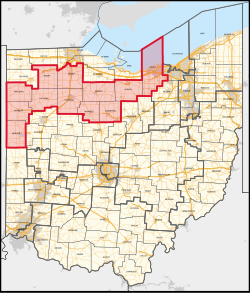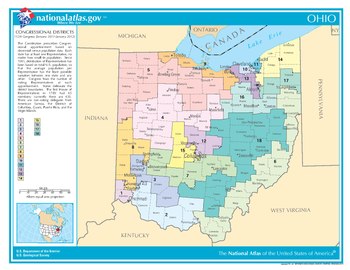
Ohio is divided into 15 congressional districts, each represented by a member of the United States House of Representatives. After the 2010 census, Ohio lost two House seats due to slow population growth compared to the national average,[1] and a new map was signed into law on September 26, 2011. Starting in the 2022 midterms, per the 2020 United States census, Ohio will lose a congressional seat.[2]
Current districts and representatives
The following table is a list of members of the United States House delegation from Ohio, their terms, their district boundaries, and the district political ratings according to the CPVI. The delegation in the 118th United States Congress has a total of 15 members, with 9 Republicans, 5 Democrats, and 1 vacancy.
| Current U.S. representatives from Ohio | |||||
|---|---|---|---|---|---|
| District | Member (Residence)[3] |
Party | Incumbent since | CPVI (2022)[4] |
District map |
| 1st |  Greg Landsman (Cincinnati) |
Democratic | January 3, 2023 | D+2 | 
|
| 2nd |  Brad Wenstrup (Hillsboro) |
Republican | January 3, 2013 | R+25 | 
|
| 3rd |  Joyce Beatty (Columbus) |
Democratic | January 3, 2013 | D+20 | 
|
| 4th |  Jim Jordan (Urbana) |
Republican | January 3, 2007 | R+20 | 
|
| 5th |  Bob Latta (Bowling Green) |
Republican | December 11, 2007 | R+15 | 
|
| 6th | Vacant | January 21, 2024 | R+16 | 
| |
| 7th |  Max Miller (Rocky River) |
Republican | January 3, 2023 | R+7 | 
|
| 8th |  Warren Davidson (Troy) |
Republican | June 7, 2016 | R+14 | 
|
| 9th |  Marcy Kaptur (Toledo) |
Democratic | January 3, 1983 | R+3 | 
|
| 10th |  Mike Turner (Dayton) |
Republican | January 3, 2003 | R+4 | 
|
| 11th |  Shontel Brown (Warrensville Heights) |
Democratic | November 4, 2021 | D+28 | 
|
| 12th |  Troy Balderson (Zanesville) |
Republican | September 5, 2018 | R+18 | 
|
| 13th |  Emilia Sykes (Akron) |
Democratic | January 3, 2023 | R+1 | 
|
| 14th |  Dave Joyce (South Russell) |
Republican | January 3, 2013 | R+9 | 
|
| 15th |  Mike Carey (Columbus) |
Republican | November 4, 2021 | R+6 | 
|
Historical district boundaries


Obsolete districts
- Ohio's at-large congressional district
- Ohio's 16th congressional district
- Ohio's 17th congressional district
- Ohio's 18th congressional district
- Ohio's 19th congressional district
- Ohio's 20th congressional district
- Ohio's 21st congressional district
- Ohio's 22nd congressional district
- Ohio's 23rd congressional district
- Ohio's 24th congressional district
Redistricting challenges
2019 challenge
On May 3, 2019, a three-judge panel from the United States District Court for the Southern District of Ohio declared Ohio's 2012 district map contrary to Article One of the United States Constitution, as "an unconstitutional partisan gerrymander" and ordered "the enactment of a constitutionally viable replacement" prior to the 2020 elections.[6] An appeal made to the U.S. Supreme Court resulted in the order to redraw the map being nullified.[7]
2022 redistricting
On November 17, 2021, after lengthy discussions, a new map was passed by the Ohio House of Representatives 55-36, along party lines, with no Democrat voting in favor of the map.[8] The map was sent to Governor of Ohio, Mike DeWine, where he accepted it 3 days later on November 20.[9]
The map has been controversial, as Democrats accuse the map of being purposefully designed to benefit Republicans.[8][9] By December 7, 2021, six lawsuits had been filed against the new 15-seat congressional map, citing it as "racially discriminatory". The proposed map favors Republican to Democratic districts by a 12-3 margin.[10]
On January 14, 2022, the Ohio Supreme Court declared the map a partisan gerrymander, violating Article XIX of the Constitution of Ohio, in a 4-3 decision. The Ohio General Assembly had 30 days to draw a new map.[11]
On March 16, 2022, the Ohio Supreme Court rejected the new proposed state legislative district map for the third time.[12] In spite of the decision, the primary elections scheduled to take place on May 3 were held using the second set of districts. Even though the maps were struck down, the state’s constitution allows for the second version to be used for the primary elections because a third proposal won’t be ready until after the May 3 primary.[13][14]
See also
- List of United States congressional districts
- United States congressional delegations from Ohio
- History of 19th-century congressional redistricting in Ohio
References
- ^ Wang, Robert (December 21, 2010). "Census costs Ohio two seats in Congress". The Canton Repository. Retrieved November 4, 2015.
- ^ Merica, Dan; Stark, Liz (April 26, 2021). "Census Bureau announces 331 million people in US, Texas will add two congressional seats". CNN. Retrieved April 26, 2021.
- ^ "Office of the Clerk, U.S. House of Representatives". clerk.house.gov. Retrieved January 6, 2022.
- ^ "2022 Cook PVI: District Map and List". The Cook Political Report. July 12, 2022. Retrieved January 5, 2023.
- ^ "The national atlas". nationalatlas.gov. Archived from the original on February 22, 2014. Retrieved February 22, 2014.
- ^ Rosenberg, Gabe (May 3, 2019). "Federal Court Throws Out Ohio's Congressional Map". National Public Radio (NPR). Retrieved May 5, 2019.
- ^ "U.S. Supreme Court tosses challenge to Republican-drawn Ohio congressional maps". Reuters. October 8, 2019. Retrieved April 4, 2020.
- ^ a b Balmert, Jessie. "Ohio Republicans propose congressional district maps advantaging the GOP. See them here". The Columbus Dispatch. Retrieved November 23, 2021.
- ^ a b "Ohio governor signs new congressional district map into law". ABC News. Retrieved November 23, 2021.
- ^ "Federal lawsuit says Ohio's new state legislative, congressional maps discriminate against Black voters". cleveland.com. Retrieved December 7, 2021.
- ^ Uniss, Kyle Anne (January 14, 2022). "Ohio Supreme Court invalidates GOP-drawn congressional districts". Courthouse News Service. Archived from the original on January 16, 2022. Retrieved January 16, 2022.
- ^ Andy Chow (March 16, 2022). "Ohio Supreme Court March 16, 2022 ruling on state legislative maps". Scribd. Retrieved March 18, 2022.
- ^ Staff (May 3, 2022). "Ohio Primary Election Results". New York Times. Retrieved August 9, 2023.
- ^ Michael Wines (March 17, 2022). "In Ohio, a Standoff Over Political Maps Threatens the Next Elections". New York Times. Retrieved March 18, 2022.
External links
- Rose Institute of State and Local Government, "Ohio: 2010 Redistricting Changes", Redistricting by State, Claremont, CA: Claremont McKenna College
